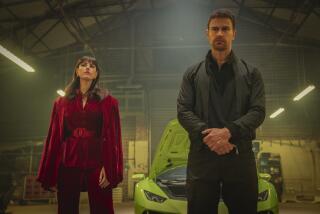‘Green’ With Finney : Timing is perfect for actor to play a role that eluded him two decades ago
- Share via
London — Albert Finney was not wholly unfamiliar with “The Green Man” when he was offered the lead role in the new television adaption of the Kingsley Amis thriller.
Just after publication of the 1969 novel about the strange goings-on at a haunted English country inn, the British actor optioned the book for his own film production company.
Finney, then in his early 30s, was too young to play Maurice Allington, the sophisticated, alcoholic proprietor of the inn called “The Green Man.” The worldly Allington, who seeks out, and ultimately confronts, the cause of the supernatural events enveloping the inn, is meant to be played by an older man.
But although youth barred him from the juicy role, Finney was keen to participate as producer of a film version of the story. Financing was impossible to obtain, however, and his small company had to let its option lapse.
Over the years, others also tried unsuccessfully to translate Amis’ story, which is both spooky and humorous, to film. American director Walter Hill attempted a version that moved the story from the English countryside to a small town on the East Coast of the United States. But he also was frustrated in his efforts.
We couldn’t crack it “and no one else could either,” Finney said, between sips of tea in a restaurant near his home in London’s fashionable Chelsea district.
Twenty years after Finney optioned the novel, the BBC obtained rights to make a television film of “The Green Man” in a co-production arrangement with the Arts & Entertainment Network. Then, by “absolute coincidence,” said Finney, the new producers offered him the role of Allington.
“What was so strange was that I was now the right age to play the part,” said Finney, 55.
The TV movie, which aired in three parts last year in Great Britain will appear on A&E; tonight, repeating Thursday and Friday nights.
Finney, whose films include “Saturday Night and Sunday Morning,” “Tom Jones,” “The Dresser,” and the Coen brothers’ recent gangster movie “Miller’s Crossing,” watched the “The Green Man” on TV and thought it worked well on the small screen. In fact, he came to believe that it was better-suited as a television project than a feature film.
One of the problems that hindered attempts to dramatize “The Green Man,” said Finney, was the complicated twists and turns of the novel. In the BBC production, the novel was transformed into three 50-minute segments.
“When I saw it on television,” said Finney, in his deep, resonant voice, “I thought perhaps that is where it belonged--to make a sort of cliffhanger out of it. Perhaps if one was going to make a film of it, one would have had to simplify the plot. There are so many little threads to ‘The Green Man,’ that maybe somehow it works better as a rather rich, light souffle that’s whipped up, as it were, in front of your eyes, rather than as a feature film that you have to go along and give yourself to.”
Finney credits director Elijah Moshinsky, who is internationally known for his work in directing opera, for smoothly transforming the book into film. “You couldn’t smell the leather of the novel having laid on the bookshelf,” said the actor. “Often, when adaptations of books are made, there’s a sort of inevitable literary-ness about them. But I thought that he really translated it into visual terms.”
“The Green Man” is not just the name of the inn, but also, as English schoolchildren know, the bogeyman who lives in the woods.
In the film, Allington is seen as a host who likes to regale his restaurant customers with tales of the supposed ghosts that haunt the premises. A certain Dr. Thomas Underhill, a 17th-Century doctor of divinity, was said to have committed a number of horrible crimes at the inn, including the murder of his wife, and was now, some believed, still lurking in the medieval inn.
Allington doesn’t believe any of it at first. But after he has a series of visions and strange encounters--which most of his friends attribute to his incessant drinking--he is convinced that Underhill remains a force of evil. Only his teen-age daughter Amy and his daughter-in-law Lucy, who is drawn to things mystic, believe that Allington is on to something.
Eventually, Allington is visited by a corporeal, but God-like being, who asks for a Scotch and tells him to stop Underhill. “One bit of advice,” the supreme being tells Allington. “Use the Church where appropriate. Your priest has certain techniques at his disposal.”
That leads to the involvement of a rather offbeat priest, who is rather skeptical about the whole affair, but whose participation becomes crucial.
Although Amis’ story of “The Green Man” was set in the 1960s, the TV movie required only a minimum of updating. “In the original novel, Maurice Allington’s daughter-in-law was a flower person,” Finney said. “Now she becomes a New Age person dealing in crystals.”
The young priest, who admits to doubts about the existence of an afterlife, “is what we used to call a ‘trendy vicar’ in the ‘60s, which is still quite usable,” Finney said.
Playing the Allington role required Finney to participate in a number of special-effects scenes. Among them were sequences straight out of the “Roger Rabbit” school of filmmaking, in which he had to pretend to interact with images which would be added later to the film.
“I’ve not done a lot of reacting to things that aren’t quite there,” he said. “It’s not often I have to react to, say, birds swooping down. I don’t know how Bob Hoskins did that rabbit picture.”
“The Green Man” airs today at 5 p.m. and 9 p.m. and repeats Thursday and Friday at 6 p.m. and 10 p.m. on the Arts & Entertainment Network.
More to Read
Only good movies
Get the Indie Focus newsletter, Mark Olsen's weekly guide to the world of cinema.
You may occasionally receive promotional content from the Los Angeles Times.










